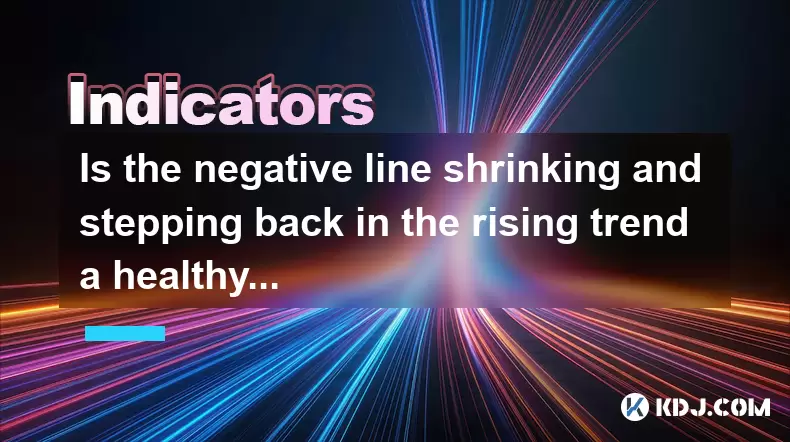-
 Bitcoin
Bitcoin $118100
0.44% -
 Ethereum
Ethereum $3765
5.84% -
 XRP
XRP $3.498
3.12% -
 Tether USDt
Tether USDt $1.000
0.00% -
 BNB
BNB $753.2
3.41% -
 Solana
Solana $181.7
3.58% -
 USDC
USDC $0.9999
0.01% -
 Dogecoin
Dogecoin $0.2704
12.75% -
 Cardano
Cardano $0.8684
5.85% -
 TRON
TRON $0.3151
-0.86% -
 Hyperliquid
Hyperliquid $46.06
4.51% -
 Stellar
Stellar $0.4695
2.48% -
 Sui
Sui $3.910
3.18% -
 Chainlink
Chainlink $19.36
6.65% -
 Hedera
Hedera $0.2750
3.99% -
 Bitcoin Cash
Bitcoin Cash $544.6
6.31% -
 Avalanche
Avalanche $25.12
3.69% -
 Shiba Inu
Shiba Inu $0.00001559
5.40% -
 Litecoin
Litecoin $116.8
5.10% -
 UNUS SED LEO
UNUS SED LEO $8.991
0.05% -
 Toncoin
Toncoin $3.283
2.79% -
 Polkadot
Polkadot $4.509
3.97% -
 Uniswap
Uniswap $10.67
6.58% -
 Ethena USDe
Ethena USDe $1.001
-0.01% -
 Monero
Monero $323.2
0.48% -
 Pepe
Pepe $0.00001410
6.37% -
 Bitget Token
Bitget Token $4.964
1.93% -
 Dai
Dai $0.9998
-0.01% -
 Aave
Aave $326.2
3.85% -
 Bittensor
Bittensor $421.8
2.46%
Is the negative line shrinking and stepping back in the rising trend a healthy adjustment?
A shrinking negative line in a rising crypto trend often signals weakening bearish pressure, suggesting the uptrend may remain intact amid normal market corrections.
Jun 29, 2025 at 04:49 pm

Understanding the Concept of a Negative Line in Cryptocurrency Charts
In cryptocurrency trading, the negative line typically refers to a technical indicator or pattern that suggests bearish movement within an overall bullish trend. This can manifest as a red candlestick on a price chart, a downward movement in a moving average, or a decline in volume or momentum indicators like RSI or MACD. When this occurs during a rising trend, it raises questions about the health of the uptrend and whether traders should be concerned.
The negative line is not inherently dangerous, but its appearance must be interpreted within context. In many cases, especially in volatile markets like crypto, short-term pullbacks are normal and expected.
Why Do Pullbacks Occur in Rising Trends?
Cryptocurrency markets are known for their volatility, which means that rapid upward movements often trigger profit-taking or short-term corrections. Pullbacks during uptrends are natural market behaviors driven by several key factors:
- Profit Taking: Traders who entered positions earlier may sell to lock in gains.
- Market Sentiment Shifts: News events or macroeconomic data can temporarily disrupt bullish sentiment.
- Technical Resistance Testing: Price may retreat slightly before breaking through resistance levels.
- Volume Imbalances: Sudden drops in buying pressure can cause temporary dips.
These behaviors do not necessarily indicate a reversal, especially if underlying fundamentals and long-term trends remain intact.
How to Identify Healthy vs. Unhealthy Adjustments
Not all pullbacks are created equal. It's crucial to distinguish between a healthy adjustment and a potential trend reversal. Here are some signs that a negative line might represent a healthy correction:
- Decreased Volume During the Dip: A shrinking negative line with reduced trading volume often signals a lack of aggressive selling.
- Maintaining Key Support Levels: If the price holds above critical support zones (e.g., 20-day moving average), the uptrend may still be valid.
- Quick Recovery: A swift rebound after a brief dip shows strong buyer interest.
- Positive Divergence in Momentum Indicators: Tools like RSI or MACD showing positive divergence suggest strength building beneath the surface.
Conversely, if the negative line breaks below major support levels with high volume, it could signal a more serious shift in market dynamics.
Analyzing Real-Time Examples from Crypto Markets
Let’s consider a real-world example using Bitcoin’s price action in late 2023. After reaching $35,000, BTC experienced a minor pullback to $33,000 over two days. During this time, the RSI dipped into neutral territory but did not enter oversold conditions. Volume also declined during the drop, suggesting that sellers were not overwhelming buyers.
This was a textbook example of a healthy adjustment. The price then resumed its upward trajectory, eventually surpassing $40,000 shortly afterward.
Another case involved Ethereum in early 2024, where ETH corrected from $2,200 to $2,000 over three days. Despite the drop, on-chain metrics such as active addresses and gas usage remained stable, indicating continued network activity and confidence.
Practical Steps for Evaluating a Negative Line in Uptrends
If you're analyzing a chart and notice a negative line forming within a rising trend, follow these steps to assess the situation accurately:
- Confirm the Trend Context: Use longer timeframes (like daily or weekly charts) to understand whether the overall trend is bullish.
- Check Volume Patterns: Look for decreasing volume during the pullback and increasing volume on the bounce back.
- Monitor Key Technical Levels: Ensure that the price hasn't breached important moving averages or horizontal supports.
- Analyze Momentum Indicators: Check RSI, MACD, and Stochastic for signs of weakness or strength during the dip.
- Watch On-Chain Metrics: For assets like Bitcoin or Ethereum, tools like Glassnode can provide insights into accumulation or distribution patterns.
By following these analytical steps, traders can make more informed decisions rather than reacting emotionally to short-term price drops.
FAQs
Q: What does a shrinking negative line mean in a rising trend?
A: A shrinking negative line indicates that the bearish pressure is weakening even though a pullback is occurring. It often suggests that the uptrend remains intact and that the pullback is a normal part of market behavior.
Q: Should I buy during a pullback in a rising trend?
A: Buying during a pullback can be a strategic move if certain conditions are met, such as strong volume on the rebound, no break below key support levels, and positive momentum indicators. However, always use stop-loss orders to manage risk.
Q: How long should a healthy adjustment last in crypto markets?
A: There's no fixed duration, but healthy adjustments in crypto usually last anywhere from a few hours to several days. Extended pullbacks beyond a week without clear signs of recovery may warrant closer scrutiny.
Q: Can a negative line ever be a false signal?
A: Yes, especially in highly volatile crypto markets. Sometimes, a negative line appears due to short-term panic selling or algorithmic trading noise. Confirming with other indicators helps avoid false alarms.
Disclaimer:info@kdj.com
The information provided is not trading advice. kdj.com does not assume any responsibility for any investments made based on the information provided in this article. Cryptocurrencies are highly volatile and it is highly recommended that you invest with caution after thorough research!
If you believe that the content used on this website infringes your copyright, please contact us immediately (info@kdj.com) and we will delete it promptly.
- Tezos, Conflux, and the Altcoin Rebound: What's Driving the Surge?
- 2025-07-21 14:50:12
- DeFi Evolution: Data Oracles and NFT Integration Leading the Charge
- 2025-07-21 14:30:12
- Super Apps, Stablecoins, and Future Payments: A NYC Perspective
- 2025-07-21 14:30:12
- Cardano (ADA) Price Surges Amid Bitcoin ATH Buzz: What's Next?
- 2025-07-21 12:30:11
- Bitcoin, UK, and Sale: Decoding the Crypto Buzz in Britain
- 2025-07-21 12:30:11
- Ethereum NFT Torch: Celebrating 10 Years of Innovation
- 2025-07-21 12:50:12
Related knowledge

Advanced RSI strategies for crypto
Jul 13,2025 at 11:01am
Understanding the Basics of RSI in Cryptocurrency TradingThe Relative Strength Index (RSI) is a momentum oscillator used to measure the speed and chan...

Crypto RSI for day trading
Jul 12,2025 at 11:14am
Understanding RSI in the Context of Cryptocurrency TradingThe Relative Strength Index (RSI) is a momentum oscillator used to measure the speed and cha...

Crypto RSI for scalping
Jul 12,2025 at 11:00pm
Understanding RSI in the Context of Crypto TradingThe Relative Strength Index (RSI) is a momentum oscillator widely used by traders to measure the spe...

What does an RSI of 30 mean in crypto
Jul 15,2025 at 07:07pm
Understanding RSI in Cryptocurrency TradingRelative Strength Index (RSI) is a momentum oscillator widely used in cryptocurrency trading to measure the...

What does an RSI of 70 mean in crypto
Jul 13,2025 at 06:07pm
Understanding the RSI Indicator in Cryptocurrency TradingThe Relative Strength Index (RSI) is a widely used technical analysis tool that helps traders...

Does RSI work in a bear market for crypto
Jul 16,2025 at 01:36pm
Understanding RSI in Cryptocurrency TradingThe Relative Strength Index (RSI) is a momentum oscillator used by traders to measure the speed and change ...

Advanced RSI strategies for crypto
Jul 13,2025 at 11:01am
Understanding the Basics of RSI in Cryptocurrency TradingThe Relative Strength Index (RSI) is a momentum oscillator used to measure the speed and chan...

Crypto RSI for day trading
Jul 12,2025 at 11:14am
Understanding RSI in the Context of Cryptocurrency TradingThe Relative Strength Index (RSI) is a momentum oscillator used to measure the speed and cha...

Crypto RSI for scalping
Jul 12,2025 at 11:00pm
Understanding RSI in the Context of Crypto TradingThe Relative Strength Index (RSI) is a momentum oscillator widely used by traders to measure the spe...

What does an RSI of 30 mean in crypto
Jul 15,2025 at 07:07pm
Understanding RSI in Cryptocurrency TradingRelative Strength Index (RSI) is a momentum oscillator widely used in cryptocurrency trading to measure the...

What does an RSI of 70 mean in crypto
Jul 13,2025 at 06:07pm
Understanding the RSI Indicator in Cryptocurrency TradingThe Relative Strength Index (RSI) is a widely used technical analysis tool that helps traders...

Does RSI work in a bear market for crypto
Jul 16,2025 at 01:36pm
Understanding RSI in Cryptocurrency TradingThe Relative Strength Index (RSI) is a momentum oscillator used by traders to measure the speed and change ...
See all articles

























































































